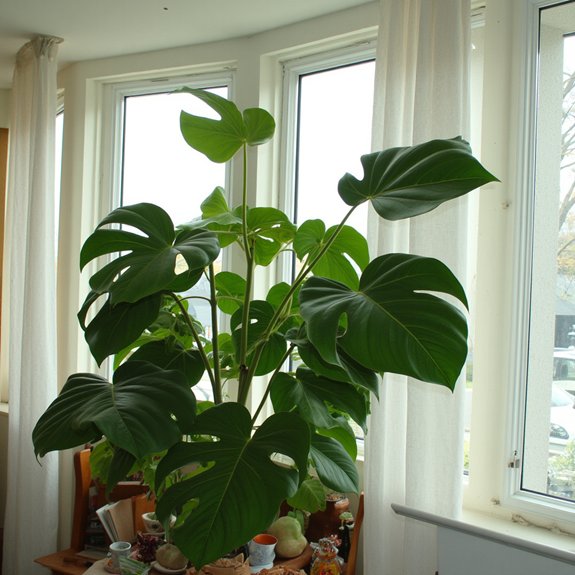You’ve probably heard whispers about the Philodendron Gigas in plant collector circles, and there’s good reason for the buzz. This rare tropical stunner demands precision in care, but don’t let that intimidate you. With its massive, velvety leaves that can reach epic proportions, it’s worth mastering the specific techniques. Getting the humidity, light, and watering balance right isn’t just important—it’s absolutely critical for survival, and one misstep can spell disaster.
Contents
- 1 Understanding Philodendron Gigas: A Rare Tropical Beauty
- 2 Optimal Soil Requirements and Potting Essentials
- 3 Light Conditions for Healthy Growth
- 4 Temperature Management and Climate Control
- 5 Watering Techniques and Moisture Balance
- 6 Humidity Requirements and Environmental Adjustments
- 7 Fertilization Schedule and Nutrient Needs
- 8 Troubleshooting Common Care Issues and Problems
Understanding Philodendron Gigas: A Rare Tropical Beauty

When you first encounter a Philodendron Gigas, you’ll immediately notice its striking velvet-textured leaves that shimmer with an almost metallic quality. This rare beauty emerged in Philodendron history when researchers discovered it in Panama’s tropical habitats back in 1997. You’re looking at a plant that can stretch over 50 feet in its native tropical habitats, though your indoor specimen will stay more manageable. The leaves start as coppery green newcomers, then mature into deep, rich green ovals that distinguish it from its heart-shaped cousin, Melanochrysum. It’s a fast grower that’ll reach your ceiling surprisingly quickly.
Optimal Soil Requirements and Potting Essentials
Three key elements determine your Philodendron Gigas’s success: drainage, moisture retention, and proper aeration. Your soil mix should combine high-quality potting soil with perlite, coconut coir, or orchid bark for best results. Test drainage before potting—water should flow through easily without leaving soggy spots.
When repotting, match your existing soil mix closely to prevent transplant shock. Allow new plants to acclimatize for several weeks before changing containers. Young plants need annual repotting, while mature specimens may require more frequent attention.
Proper potting techniques include ensuring drainage holes exist and avoiding compacted soil that restricts root growth.
Light Conditions for Healthy Growth

Since Philodendron Gigas evolved beneath Panama’s forest canopy, it craves bright indirect light that mimics those dappled conditions. Place yours near east-facing windows where morning sun won’t scorch the leaves. If you’ve got south or west windows, hang sheer curtains to filter the light intensity.
Your plant will tolerate lower light, but growth slows dramatically. Prolonged dim conditions invite root rot, while excess indirect sunlight causes brown patches on those gorgeous velvet leaves. Aim for that sweet spot where light feels bright but never harsh. Think filtered sunshine, not blazing rays.
Temperature Management and Climate Control
Beyond getting the lighting right, your Philodendron Gigas needs consistent warmth to flourish. Keep temperatures around 75°F year-round for ideal growth. Temperature fluctuations below 60°F for extended periods will stress your plant, causing stunted development and potential leaf drop.
During summer months, watch for excessive heat above 90°F. Your Gigas will need more frequent watering and possibly relocation to cooler spots. Climate adaptations help, but sudden changes shock the plant’s system.
Avoid placing your Gigas near heating vents, air conditioners, or drafty windows. These create harmful temperature swings that disrupt growth patterns and weaken your plant’s overall health.
Watering Techniques and Moisture Balance

While temperature creates the foundation for healthy growth, proper watering techniques determine whether your Philodendron Gigas thrives or struggles. Check the top inch or two of soil before watering—it should feel dry to your fingertip. Your watering frequency depends on humidity, temperature, and soil composition, typically every 7-10 days during growing season.
Focus on moisture retention by using well-draining soil that holds water without becoming soggy. Water thoroughly until it drains from the bottom holes, then empty the saucer within 30 minutes. This prevents root rot while ensuring deep hydration reaches all roots effectively.
Humidity Requirements and Environmental Adjustments
Proper watering sets the stage, but humidity levels make the difference between surviving and flourishing for your Philodendron Gigas. Your plant craves 75% humidity, mimicking its Panama rainforest home, though it’ll tolerate 50% minimum. Bathrooms and kitchens serve as excellent humidity sources, naturally maintaining higher moisture levels. You can also use pebble trays filled with water or invest in a humidifier for consistent results. Watch for humidity indicators like brown leaf edges, which signal dry air stress. Grouping plants together creates beneficial microclimates, while misting provides temporary relief but shouldn’t replace proper humidity sources.
Fertilization Schedule and Nutrient Needs
Although your Philodendron Gigas grows naturally without supplements in Panama’s rich forest floor, indoor conditions demand regular feeding to maintain those stunning velvet leaves. During spring and summer, apply balanced liquid fertilizer every 2-3 weeks. Look for nutrient ratios like 10-10-10 or 20-20-20, which provide equal parts nitrogen, phosphorus, and potassium. Higher nitrogen fertilizer types can boost leaf growth dramatically. Dilute fertilizer to half-strength to prevent root burn. Skip feeding during fall and winter when growth slows. Watch for dark green foliage and robust stems, which signal proper nutrition levels.
Troubleshooting Common Care Issues and Problems
Even experienced plant parents encounter hiccups with their Philodendron Gigas, but most problems stem from just three culprits: watering mistakes, lighting issues, or humidity imbalances. Yellow leaves typically signal overwatering, while brown, crispy edges indicate underwatering or low humidity below 50%. Leaf discoloration causes also include too much direct sunlight, which creates burnt patches. For pest prevention strategies, inspect leaves weekly for spider mites or mealybugs, especially during dry conditions. Quick action saves your plant—adjust watering schedules, relocate for better light, boost humidity with pebble trays, and treat pests immediately with insecticidal soap.
